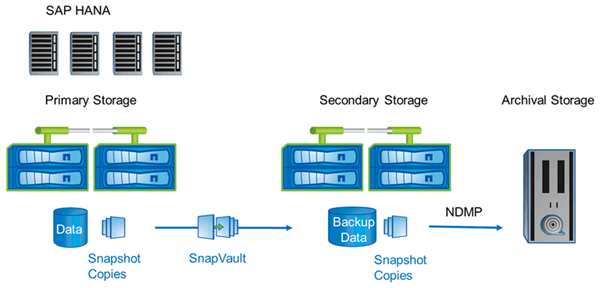The NetApp solution
 Suggest changes
Suggest changes


A database backup can be created in minutes by using NetApp Snapshot technology. The time needed to create a Snapshot copy is independent of the size of the database because a Snapshot copy does not move any data blocks.
The use of Snapshot technology also has no performance effect on the production SAP system. Therefore, the creation of Snapshot copies can be scheduled without having to consider peak activity periods. SAP and NetApp customers typically schedule several online Snapshot backups during the day. For example, backups might occur every four hours. These Snapshot backups are typically kept for three to five days on the primary storage system.
Snapshot copies also provide key advantages for the restore and recovery operation. NetApp SnapRestore functionality allows restoring the entire database or parts of the database to the point in time when any available Snapshot copy was created. This restore process is done in a few minutes, independently of the size of the database. The time needed for the recovery process is also dramatically reduced, because several Snapshot copies have been created during the day, and fewer logs need to be applied.
Snapshot backups are stored on the same disk system as the active online data. Therefore NetApp recommends using Snapshot backups as a supplement, not a replacement for backups to a secondary location such as disk or tape. Although backups to a secondary location are still necessary, there is only a slight probability that these backups will be needed for restore and recovery. Most restore and recovery actions are handled by using SnapRestore on the primary storage system. Restores from a secondary location are only necessary if the primary storage system holding the Snapshot copies is damaged or if it is necessary to restore a backup that is no longer available from a Snapshot copy. For example, you might need to restore a backup from two weeks ago.
A backup to a secondary location is always based on Snapshot copies created on the primary storage. Therefore, the data is read directly from the primary storage system without generating load on the SAP database server. The primary storage communicates directly with the secondary storage and sends the backup data to the destination using the SnapVault disk-to-disk backup. The NetApp SnapVault functionality offers significant advantages compared to traditional backups. After an initial data transfer, in which all the data has to be transferred from the source to the destination, all subsequent backups copy only the changed blocks to the secondary storage. This significantly reduces the load on the primary storage system and the time needed for a full backup. A full database backup requires less disk space because SnapVault stores only the changed blocks at the destination.
Backing up data to tape as a long-term backup might still be required. This could be, for example, a weekly backup that is kept for a year. In this case, the tape infrastructure can be directly connected to the secondary storage, and the data could be written to tape by using the Network Data Management Protocol (NDMP).



